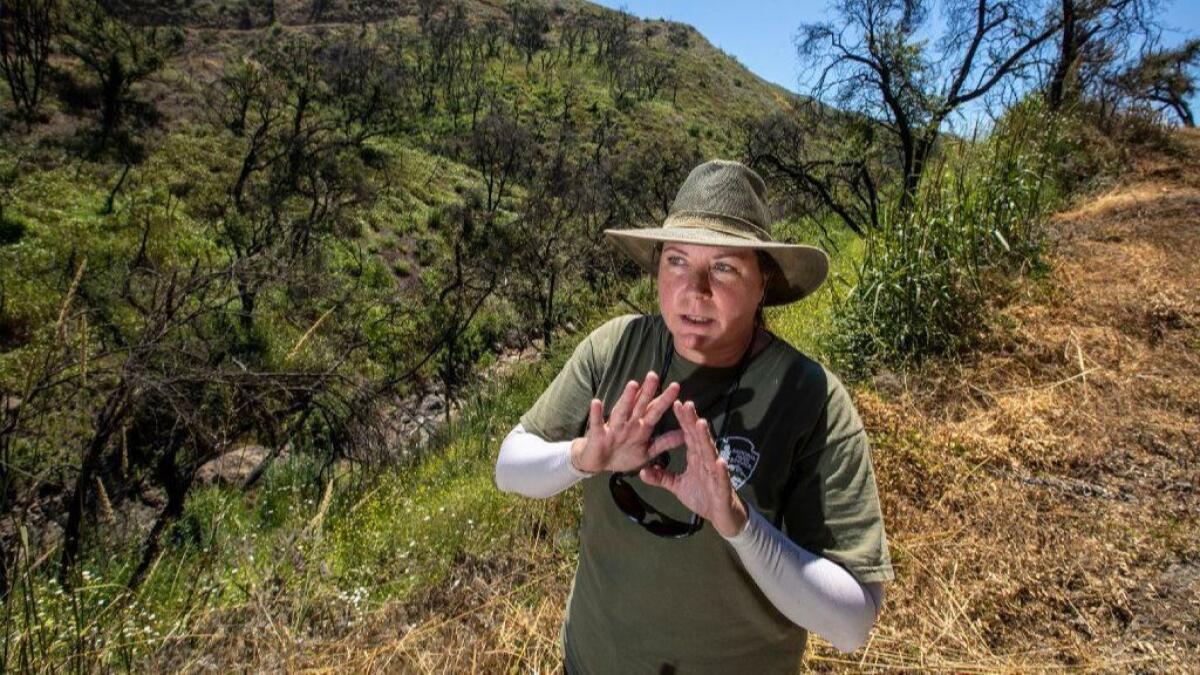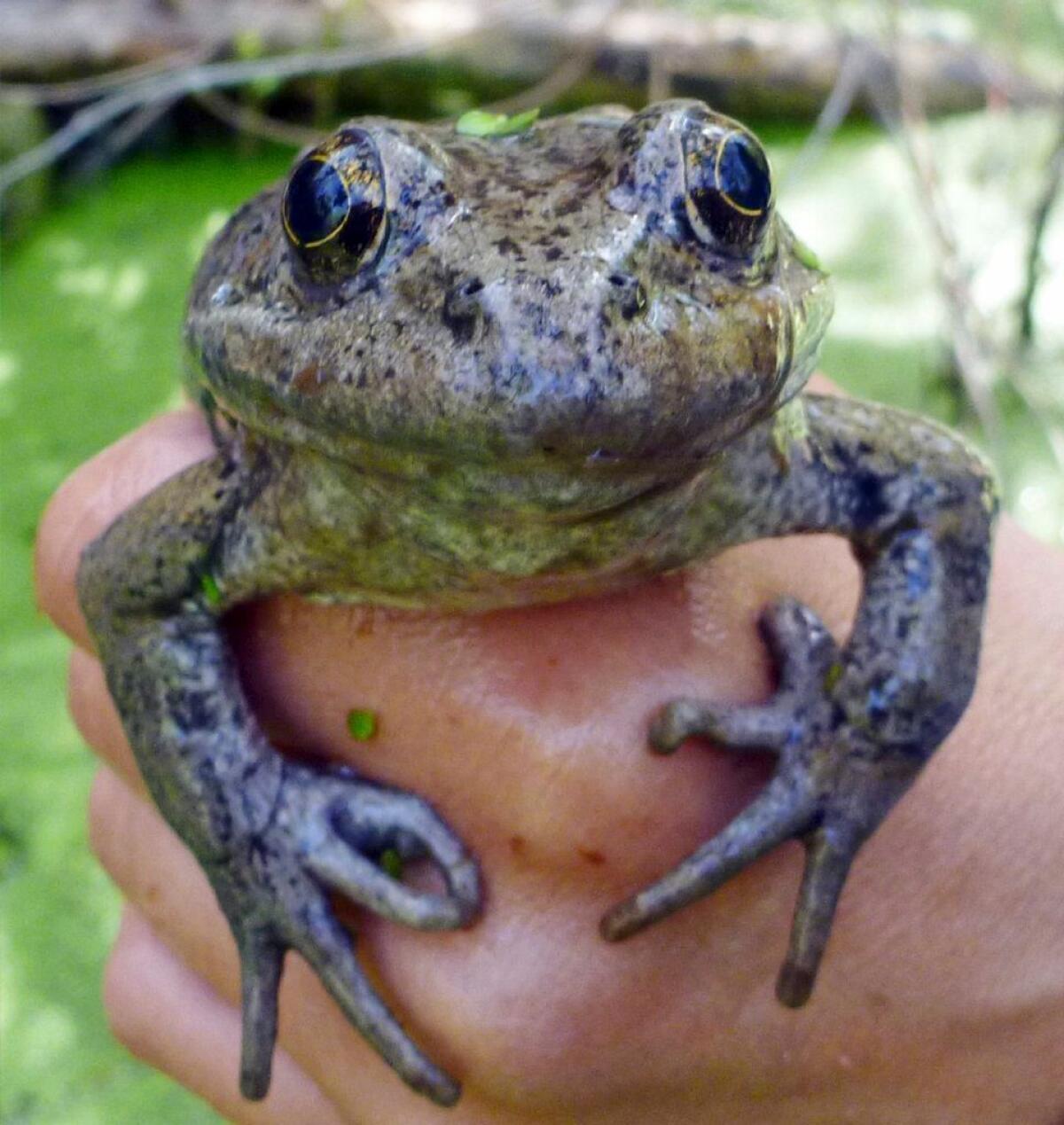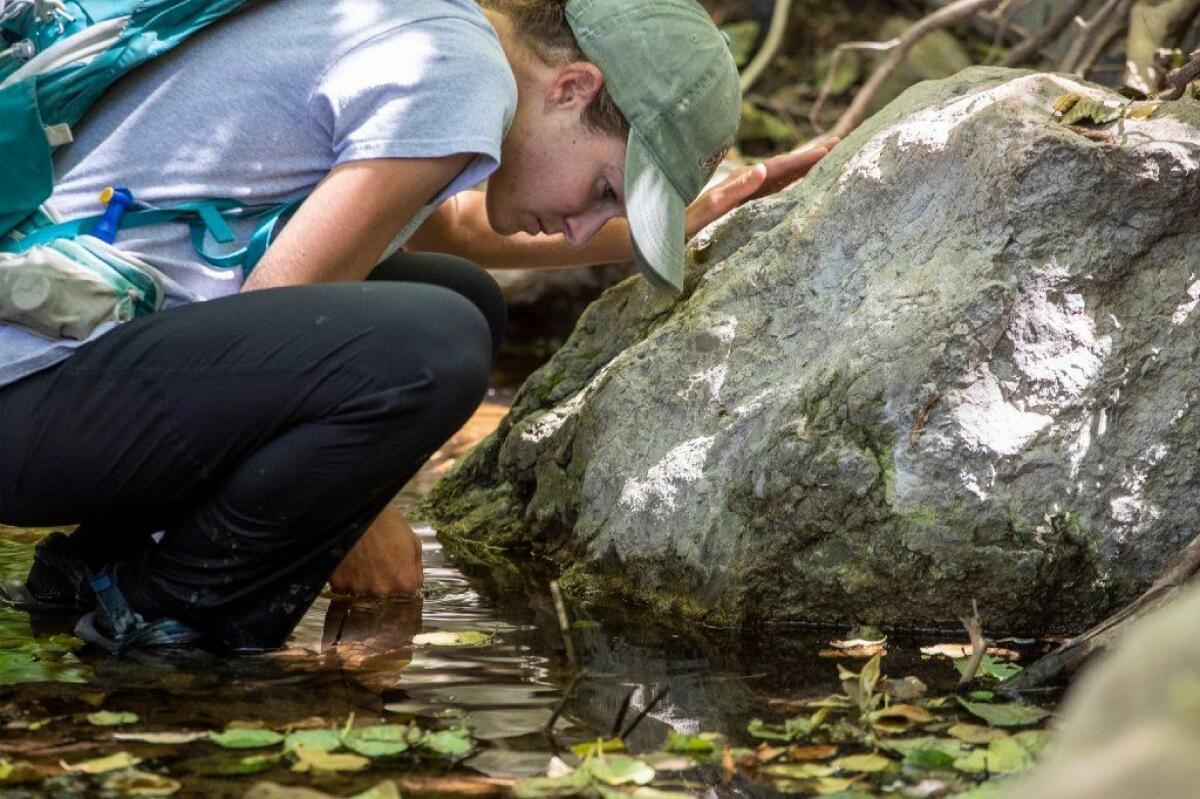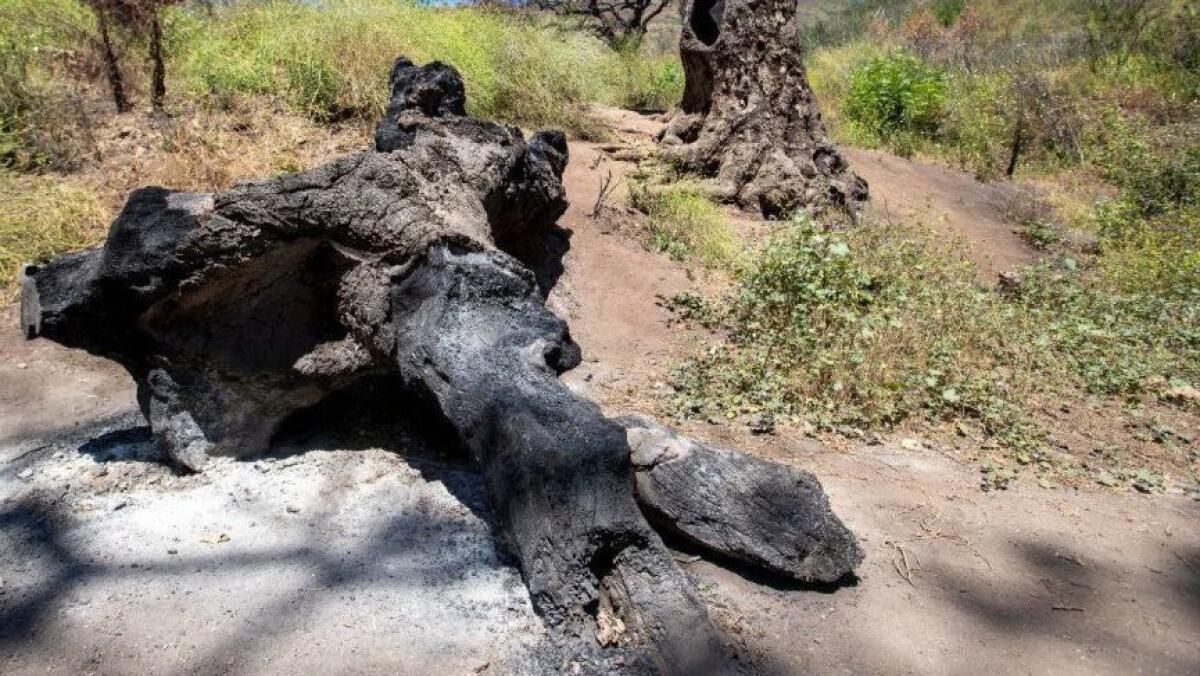The threatened frogs of the Santa Monica Mountains always had it hard. The Woolsey fire made things much worse

- Share via
Katy Delaney stood at the top of the canyon, below her feet a wooded glen transformed into a wasteland.
At the bottom, the walls of the canyon were green with new scrub. Above that, the crooked black fingers of tree branches burned crisp by fire dangled like claws.
For the record:
8:04 a.m. Aug. 1, 2019For the record: This article says that herpetologist Sarah Wenner is pursuing her master’s degree at UCLA and began working with National Park Service wildlife ecologist Katy Delaney in 2017. Wenner is pursuing her master’s at Cal State Northridge; she earned her bachelor’s degree at UCLA . She began working with Delaney in 2016.
Delaney pointed to an open patch of sediment at the base of the canyon. A year ago, pools of cool water gleamed under the sun and frogs basked on their banks. Now, a trickle of water lazed through the mud. And the California red-legged frog, whose fate had consumed eight years of Delaney’s life, was nowhere to be seen.
The wildlife ecologist for the National Park Service and her colleagues had reintroduced the vulnerable frog to four sites in the Santa Monica Mountains. They kept the locations secret.
But they couldn’t hide them from the most destructive wildfire in Los Angeles County history.
Last year, the Woolsey fire turned the land charcoal-black and the trees into skeletons. At the fried bottom of the canyon, the pools of water filled with mud and sediment. Even if the frogs survived they would have a hard time breeding in such a ravaged habitat.
It was one more hardship in the hard luck story of California’s official amphibian; and a personal heartbreak for Delaney, who said protecting the frogs had become “my baby.”
“I put these frogs here,” she said. “You know, this is my work that I spent tons of time on .... I’m very emotionally invested in them doing well I guess.”
The California red-legged frog (Rana aurora draytonii) is the largest native frog in the western United States, according to the U.S. Fish and Wildlife Service. The frog gets its name from the rosy tinge frequently found on its hind legs and abdomen.
Even in fiction, life has not been easy for the frog.

By most accounts, the star of Mark Twain’s “The Celebrated Jumping Frog of Calaveras County” was a red-legged frog. In the tale, the frog lost a jumping contest after being secretly force-fed a handful of buckshot.
Once found as far north as Shasta County and as far south as Baja California, the frog’s territory shrank year after year and its numbers diminished. They had the curse of tasting good. During the Gold Rush, miners “consumed nearly 80,000 of the frogs a year, nearly eating the species into extinction,” according to a finding by the California Legislature in 2014.
The U.S. Fish and Wildlife Service blames the frog’s degradation and loss of habitat on “agriculture, urbanization, mining, overgrazing, recreation, timber harvesting, non-native plants, impoundments, water diversions, degraded water quality, use of pesticides, and introduced predators.”
Then there was the American bullfrog, an invader from the East Coast that not only competed with smaller frogs but ate them. The bullfrog also frequently carries a skin fungus that can be deadly to other amphibians.
Then in 1957, California passed a law declaring that “any person may possess any number of live frogs to use in frog-jumping contests.”
In 1996, because of its diminished condition, the frog was declared a threatened species under the Endangered Species Act. In 2002, Fish and Wildlife hatched a recovery plan to reintroduce the frog in 35 core habitats throughout the state, including the Santa Monica Mountains, where until 1999 the frogs had not been seen in more than 20 years.
That year, an isolated population of up to 25 adult frogs was discovered in a remote area of the Simi Hills, adjacent to the Santa Monica Mountains National Recreation Area. That population would become the foundation of efforts to restore the frog to the area.
Delaney, a cheerful, hands-on ecologist with a doctorate from UCLA, joined the National Park Service in 2010 and was soon put in charge of reintroducing the frogs.
Growing up in Romeo, Mich., a suburb of Detroit, she used to watch Jacques Cousteau documentaries on television with her father. At 11, she moved with her family to San Diego and initially decided to study marine biology. At UCLA, she spent much of her time studying birds. When the Park Service hired her nine years ago, she did not know she would be assigned to work with red-legged frogs, but she jumped at the chance.
First, she searched the mountains for appropriate sites, studying maps and surveys made of the area. She pulled on her backpack and hiked to remote locations. She looked for deep pools of water. Using a scoring sheet, she evaluated each possible site, considering whether there were predators in the water, such as crayfish.
After three years they settled on four secret sites.
In the winter of 2014, Delaney and her team went to the home of the “source population” in the Simi Hills and found several masses of fertilized eggs floating on the water. She carefully scooped up a clump of several thousand eggs. They filled her two outstretched hands, gelatinous and soft.
A team member held a net beneath her hands and a spotter watched so they didn’t lose any eggs. “You have … one female’s whole reproductive effort for the year in your hand,” Delaney said.
She gently divided the mass into two parts. One went back into the water, the other into a plastic container that was put on ice. They did the same thing with several other egg masses, then they hiked to the first two secret reintroduction locations, where mesh pens in the shape of cubes were waiting. In the creek water for weeks, they had grown algae. The team lowered the eggs into the pens. And the wait began.
Weeks later, there were tadpoles. For the next two months, the tadpoles stayed in the pens, nibbling on the algae. When all the algae had been eaten, Delaney’s team started to feed the tadpoles protein pellets and Romaine lettuce. “They don’t like other lettuce,” Delaney said.
Finally, the team released the tadpoles into the streams, where they scattered and faced new dangers, such as hungry newts and fish. Delaney estimated a mortality rate of up to 99%. The team hiked to the sites several times a week, trying to catch glimpses of the elusive tadpoles. Last August they spotted tiny frogs in the stream.
It was a major milestone, but it takes frogs three years to make it to breeding age. They must survive foxes, raccoons, snakes, birds and other dangers. Delaney worried like a fretful mother.
The frogs were “sort of like teenagers,” she said. “They’re kind of wandering around and not really paying attention.”
More than a year after reintroducing frogs at the first two sites, in 2016 the team placed them at the other two. Sometimes the team would go at night to count the frogs, flashing a light into the darkness to catch the shine in their eyes. Delaney and the other team members would then try to grab the wiggly animals and tag them.
The team gave names to the pools the frogs called home. There is a Benedict Pool and a Cumberbatch Pool because of one member’s fondness for the British actor. If you fell into a pool, it sometimes got named after you.

Sarah Wenner, a herpetologist pursuing her master’s at UCLA, began to work with Delaney as a volunteer intern in 2017. Later, she was hired by the Park Service as a biological technician. She was in the field with the team when they found unmistakable evidence of wild breeding of frogs from the 2014 cohort — masses of eggs floating on the surface of a pool.
A team leader named it Sarah’s Pool, after Wenner, who was still an unpaid volunteer. But the real joy for Wenner came when the team returned to the Park Service’s offices with photos of the eggs.
She found Delaney at her desk. Instead of telling their leader what they had found, they told Delaney that there had been a problem. Look at the photos, they told her with a tone of urgency.
Two years later, Delaney still gets emotional remembering the moment.
“I started crying my eyes out.”
On Nov. 8, 2018, Delaney and her husband were boarding a flight for a long-planned European vacation when she got a text. There was a fire not far from the Santa Monica Mountains, it said.
Delaney wasn’t particularly worried. The fire was way up on the north side of the 101 Freeway.
But by the time her flight landed in London, her phone was blowing up with messages from the park superintendent, telling all team leaders to get their people out of the field. When Delaney landed in Amsterdam a few hours later, she learned that Santa Ana winds had kicked up the fire.
The Woolsey fire burned for 13 days and killed three people. More than a quarter-million people were evacuated. The fire damaged or destroyed 1,841 structures and burned 96,949 acres of land, making it one of the most destructive fires in California’s modern history.
The fire roared through the chaparral and canyons of the Santa Monica Mountains National Recreation Area, burning 88% of the park’s land, according to the National Park Service.

And it showed little mercy for the California red-legged frogs, savaging the reintroduction sites.
Mark Mendelsohn, a vegetation and wildlife biologist with the Park Service, had worked for Delaney on the reintroduction project before becoming the park’s botanist. He was the first to see the sites after the fire.
“It was awful,” he said. “Just thinking about the frogs it looked awful. It was just ... a moonscape.”
The rains that followed the fire also wreaked destruction. Streams were filled with burned debris and ash, poisoning the water. Pools that had once been deep and clear filled with mud.
At three of the four sites, Delaney said, “the habitat just got completely blown out.”
Then, days before Christmas last year, the U.S. government partially shut down and Park Service employees like Delaney were not allowed to work for 35 days.
Eventually, the team surveyed the Simi Hills source of all the frogs. They found 90 frogs. But when they returned for another visit weeks later, the frogs were noticeably skinnier. In February, with more rainfall coming, Delaney asked the Santa Barbara Zoo to shelter masses of frog eggs from the Simi Hills source. Those eggs ended up hatching tadpoles, which ended up being placed at two of the Santa Monica Mountains locations.
The frogs at the Simi Hills site have since recovered and are healthier and “breeding like crazy,” Delaney said. And at the fourth reintroduction site — the one not completely blown out — the frogs survived and have resumed breeding. “Those are my champion frogs,” Delaney said.
Maybe the California red-legged frog will see good days in the future, she said. Still, the fire has tempered some of Delaney’s former optimism.
“I think it’s going take a lot of years …. I think the habitat will recover.”
And if that is the case, and the source population remains healthy, then her team doesn’t need to completely start over, but only from “10 steps back. So I think it will eventually work.”
Delaney paused for a moment, as anyone tempted to be hopeful would when reflecting on the history of the red-legged frog.
“You know, we don’t know,” she said. “Another fire like this can happen again.”
More to Read
Sign up for Essential California
The most important California stories and recommendations in your inbox every morning.
You may occasionally receive promotional content from the Los Angeles Times.













